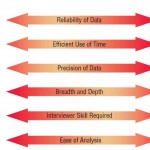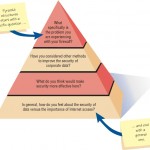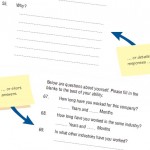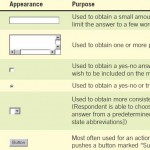There are three key interactive methods that you can use to elicit human information requirements from organizational members.These three methods are interviewing, joint application design (JAD), and surveying people through questionnaires. Although … [Read more...] about Interactive Methods of Information Gathering
Information Gathering: Interactive Methods
Interviewing in Information Gathering
Before you interview someone else, you must in effect interview yourself.You need to know your biases and how they will affect your perceptions.Your education, intellect, upbringing, emotions, and ethical framework all serve as powerful filters for … [Read more...] about Interviewing in Information Gathering
Five Steps in Interview Preparation
The five major steps in interview preparation are explained below. These steps include a range of activities from gathering basic background material to deciding who to interview. Read Background Material Read and understand as much background … [Read more...] about Five Steps in Interview Preparation
Open-Ended and Closed Type Interview Questions
Open-ended Questions Open-ended questions include those such as “What do you think about putting all the managers on an intranet?” “Please explain how you make a scheduling decision.” “In what ways does the system extend your capability to do … [Read more...] about Open-Ended and Closed Type Interview Questions
Arranging Interview Questions in a Logical Sequence
Just as there are two generally recognized ways of reasoning—inductive and deductive—there are two similar ways of organizing your interviews. A third way combines both inductive and deductive patterns. Using a Pyramid Structure Inductive … [Read more...] about Arranging Interview Questions in a Logical Sequence
Joint Application Design (JAD) in Information Gathering
No matter how adept you become as an interviewer, you will inevitably experience situations in which one-on-one interviews do not seem to be as useful as you would like. Personal interviews are time consuming and subject to error, and their data are … [Read more...] about Joint Application Design (JAD) in Information Gathering
Using Questionnaires in Information Gathering
The use of questionnaires is an information-gathering technique that allows systems analysts to study attitudes, beliefs, behavior, and characteristics of several key people in the organization who may be affected by the current and proposed systems. … [Read more...] about Using Questionnaires in Information Gathering
Writing Questions for Questionnaires
The biggest difference between the questions used for most interviews and those used on questionnaires is that interviewing permits interaction between the questions and their meanings. In an interview the analyst has an opportunity to refine a … [Read more...] about Writing Questions for Questionnaires
Using Scales in Questionnaires
Scaling is the process of assigning numbers or other symbols to an attribute or characteristic for the purpose of measuring that attribute or characteristic. Scales are often arbitrary and may not be unique. For example, temperature is measured in a … [Read more...] about Using Scales in Questionnaires
Designing and Administering the Questionnaires
Designing the Questionnaires Many of the same principles that are relevant to the design of forms for data input (as covered in Chapter 12) are important here as well. Although the intent of the questionnaire is to gather information on attitudes, … [Read more...] about Designing and Administering the Questionnaires







